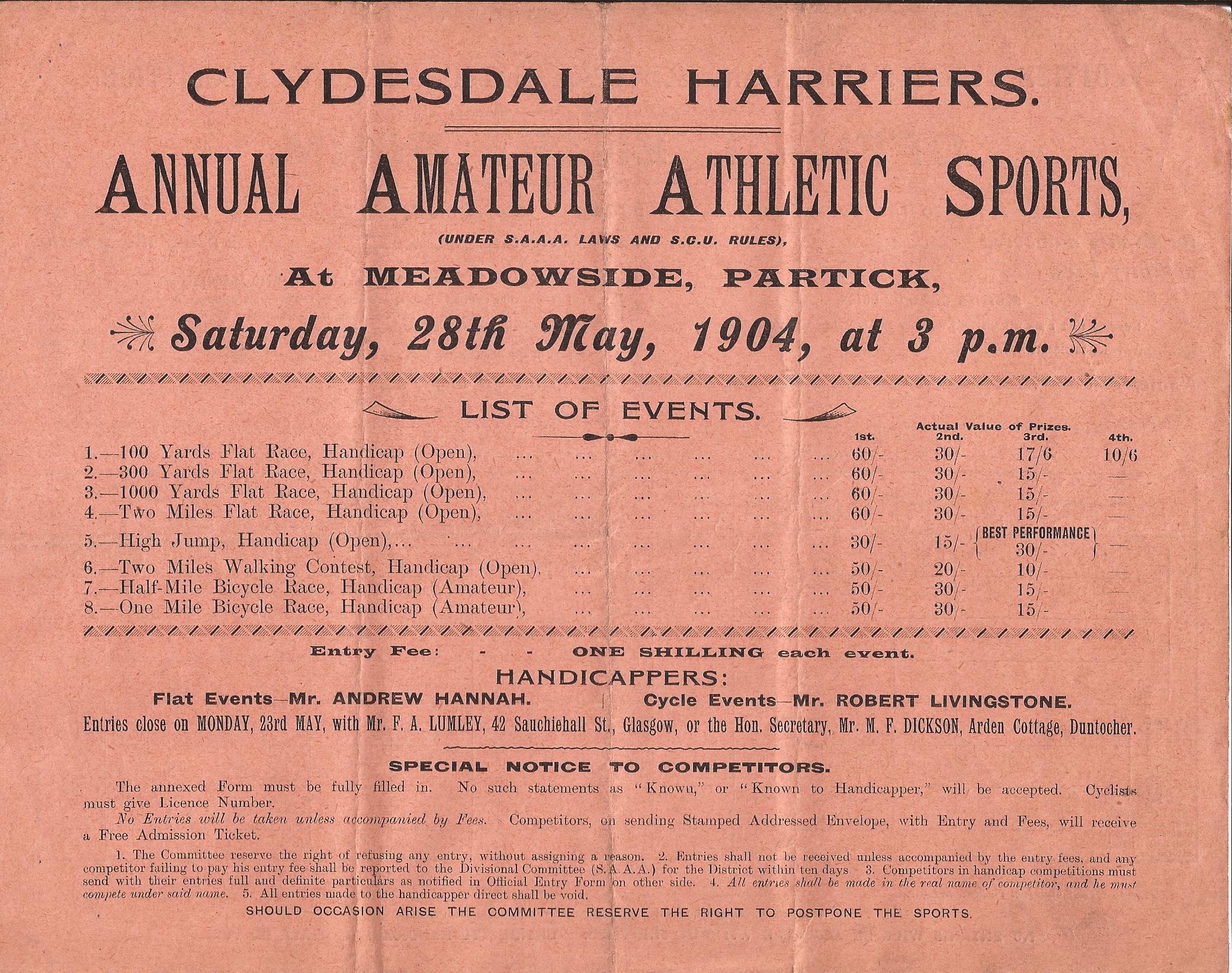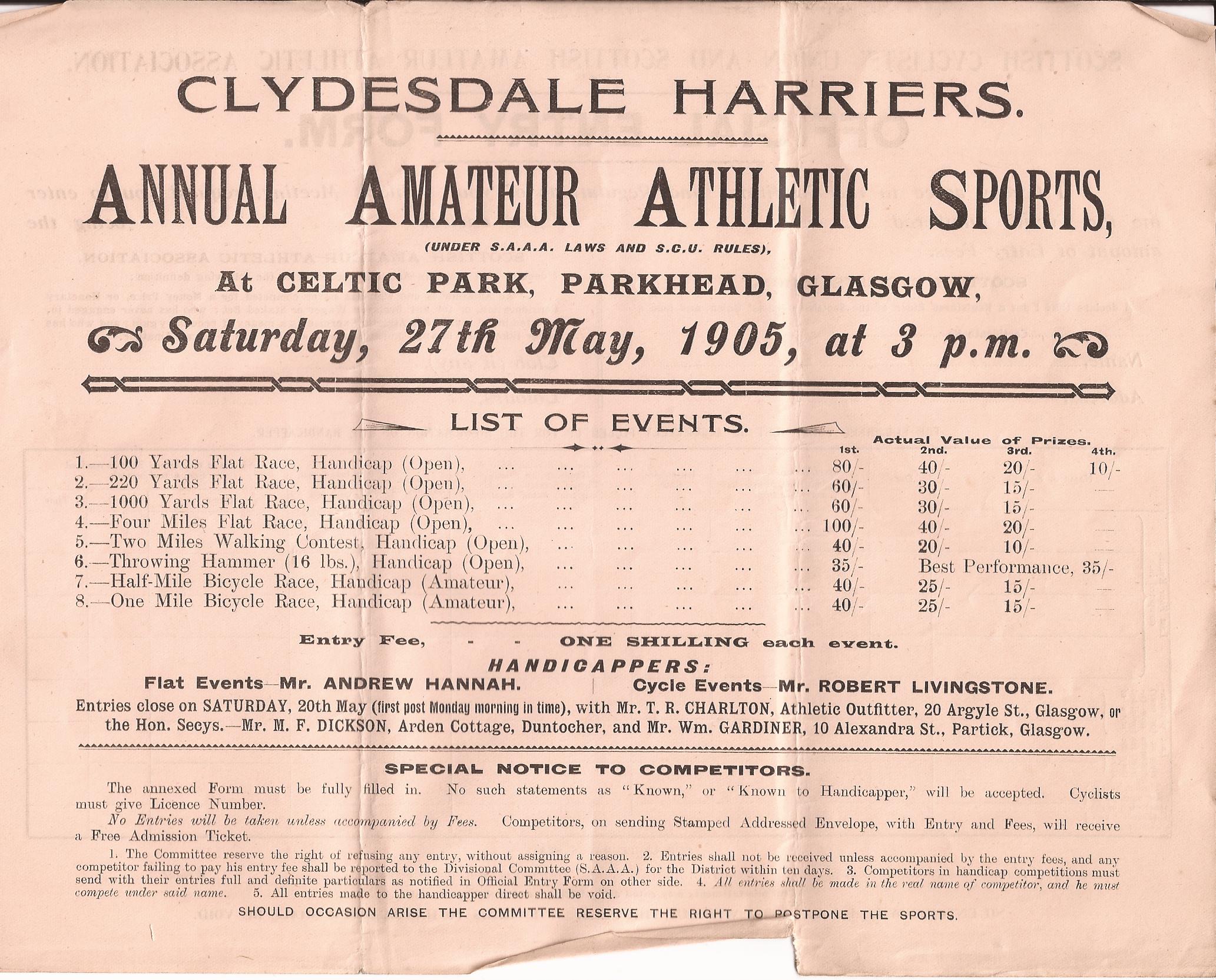There is an assumption that athletes are better catered for in the 21st century than they were in the 19th or even most of the 20th. I would say that the assumption could at least be queried. Even a quick look through the newspapers of the first half of the 20th century reveals that the quantity of track and field meetings was very high. Tracks were very busy –
- Ibrox hosted the Rangers Sports, the Glasgow Constabulary Sports, until 1922 the Clydesdale Harriers Sports, Bellahouston Harriers meetings and many more;
- Celtic Park – up to the War in 1945 – held the Celtic Sports, the Inter Club Championship organised by St Peter’s AC, some Clydesdale Harriers sports, Maryhill Harriers, West of Scotland Harriers and others,
- Hampden held the SAAA Championships regularly, international meetings and even the Maryhill Harriers club championships at which world records were set.
- Meetings were held by (1) Athletic Clubs, (2) local councils, (3) a variety of associations (eg the Deaf Blind Association held regular meetings),
- there were the Championships:- University Championships, Inter University Championships and County Championships. The Ayrshire Championships had championship events held at West Kilbride and Darvel and other venues around the county.
- Works organised Sports Meetings – Singers in Clydebank, Babcock and Wilcox’s in Paisley, Dirrans in Kilwinning are only three examples and even Junior Football clubs emulated their big brothers in having athletic sports meetings (Dalmuir FC was one such).
- The private schools such as Loretto, Glasgow Academy, Dollar Academy all had their own sports days and almost every one of them had open events from the amateur athletics circuit as well as those confined to former pupils.
They were all amateur events with few exceptions – Rangers FC, Celtic FC, Partick Thistle, St Mirren, Falkirk FC and others were in this category – with, I think, only Clyde FC Sports being professional, and for many years the Glasgow Police Sports were also professional. The Games circuit was biased the other way – almost all were professional with few being amateur. However you look at it though, there were more than enough events for an athlete to compete in in his preparation for any particular event.
Competition was always keen. The major sports meetings in Glasgow and Edinburgh always worked hard to attract the top talent to their meetings. Sometimes the athletes were specially invited, sometimes the athletes were here for an international meeting, sometimes they were on their way home from a major championships and at times there were even touring parties of Americans or British Universities stars from Oxford and Cambridge. These athletes would take part in special scratch events arranged to showcase their talent or would have the field handicapped in such a fashion as to bring out the best in them in their quest for a fast time. eg when Nurmi raced at Ibrox, Tom Blakely of Maryhill Harriers received a handicap mark of 400 yards – almost a lap. Often enough the ‘star’ failed to win but set a record or a fast time. The thrill for the spectators was seeing a quality athlete race through what might have been a top-class Scottish field.
Of course, these international athletes did not automatically decide to race at Ibrox one week, Celtic Park the next and Murrayfield later on by chance: the promoters were just that – they promoted their meetings as well as they could. The top men at the football clubs were promoters in chief. Men like Willie Maley, William Wilton and Bill Struth all went to the AAA’s championships, the Olympics and on occasion further afield to persuade the ‘stars’ to come to their meetings. There is little doubt that expenses were paid, fairly generous ones too and at one point both Rangers and Celtic were suspended from membership by the SAAA. But the athletes came – if there were not enough good Scots to make a competition, then there would be exhibition events in such as pole vault or shot putt to entertain and educate the crowds. There were even demonstration boxing matches and at one time Celtic Park had a concrete track as well as a cinder track and they held motor cycle trials on it.
The meetings were well advertised in the local and national Press, there were sporting publications with the “Scottish Referee” circulating right up to the First World War.
Compare that with the current athletics situation.

